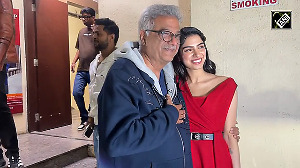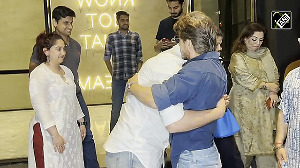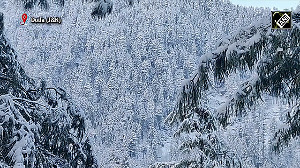In about 20 months from now, the Delhi Metro Rail Corporation will complete the first phase of its mass rapid transport system in the Capital.
The first phase will cover a distance of 62 kilometres, of which 12 kilometres are underground and the remaining 50 kilometres are on elevated corridors. And the total cost of the first phase is Rs 10,570 crore (Rs 105.7 billion).
The completion of the first phase by September 2005 essentially means that a project as gigantic as this will be implemented in a record time of seven years.
The project work started in October 1998. The first section became operational in December 2002, followed by the second section in September 2003.
The remaining five sections will be completed by September 2005. There has been no cost escalation and instead of ten years as originally planned, the entire first phase will be implemented in seven years.
For a public sector undertaking, this is a dream run. There is hardly any public sector project in this country, which has got implemented before its schedule and has not seen any cost escalation.
You might argue that the Delhi Metro managing director, E Sreedharan, has been extremely lucky in getting a huge Japanese loan (about 64 per cent of the total project cost) at an interest rate of less than 1.8 per cent.
That might have helped him keep the project cost down to $ 32-53 million per kilometre, compared to the Bangkok metro's cost of $ 56-80 million per kilometre.
But there are many other good reasons why Mr Sreedharan can hold his head high today and claim that the Delhi Metro is second to none as far as project implementation efficiencies are concerned.
And there is also no doubt that he is setting new efficiency standards as far as running a public transport utility such as the Delhi Metro is concerned.
Consider the following. The total expenditure of the Delhi Metro can be split under three broad heads -- manpower, energy and materials including maintenance and the rest.
One-third of the total cost is accounted for by manpower, one-third by energy and the remaining one-third of the cost is on account of materials use and maintenance etc. And the fact is that Mr Sreedharan has kept a tight control on expenditure under all the three heads.
He has stipulated that the total manpower strength in the company shall never exceed 45 persons per kilometre of network. This is close to the international norm. And the Kolkata Metro is still making losses probably because it employs 120 persons per kilometre of its network.
Which is also why, Mr Sreedharan is very keen on expanding the network as fast as possible. For, longer the network's distance, one-third of the costs gets more evenly distributed and the burden is that much lower.
The energy costs of the Delhi Metro have also been kept under tight control because of a special agreement it has signed with the Delhi government. This ensures that the Delhi Transco charges the Delhi Metro only the cost it incurs while purchasing power from the generators.
Thus, the Delhi Metro gets power at the cheapest possible rate. For the remaining one-third of its cost, the Delhi Metro management has put in place a system to monitor each cost item so that nothing goes out of control.
On the revenue side also, Mr Sreedharan has shown remarkable financial management skills. Drawing the right lessons from all the metro networks running in different cities in the world, he has laid adequate emphasis on non-operating revenue sources.
Thus, at present, as much as 20 per cent of the annual revenues of the Delhi Metro comes from commercial property development in the Metro station complexes and advertisements.
The Hong Kong Metro, which is the world's only profit-making mass rapid transport system, has 30 per cent of its revenues coming from such non-operating sources.
Mr Sreedharan, however, hopes to bring down the share of non-operating revenue sources in total income to about 10 per cent in the years to come. And for that he has plans to rationalise the fare structure in a manner that the Delhi Metro earns more per passenger even as it continues to drive passenger revenue growth.
He has armed himself with the Delhi Metro Act, which allows him to set up an independent three-member fare fixation committee every time the company feels the need to review the fares.
This system is unique in that it is headed by a sitting or retired high court judge, with two other members nominated by the central and the state government.
The committee is bound to give its recommendations within three months and its recommendations are binding on the Delhi Metro management. The first such committee is due to give its verdict next month.
So, the scope for political interference in the fixation of fares and consequent mismanagement of the company is reduced substantially. Once the Delhi Metro management decides that it must get its fares revised, it hands over the responsibility of fixing the new fares to a committee. It is like having an independent regulator.
Such self-imposed discipline in sensitive matters such as fare fixation in a transport network can go a long way in sustaining the good work initiated by the present management of the Delhi Metro. It will also make you wonder why autonomy should be such a big issue with so many other public sector companies.
If the Delhi Metro could achieve all this in spite of functioning within the system, why can't other public sector undertakings also create their own checks and balances and operate without political interference?






 © 2025
© 2025